Frak - clothes for the elite. But it is not necessary to be invited to a higher secular society to feel worthy of it. You can turn ordinary life into a "higher light", if you really want to wear something festive and solemn. Therefore, regardless of whether you received an invitation to an official evening event where such a dress code is supposed, or you made a holiday yourself, it will not be superfluous to know how and to whom a coat can and should be worn.
What is a suit?
-
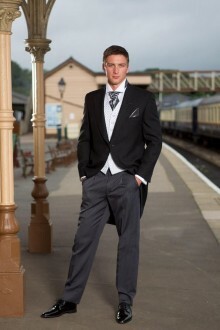 Frak - a kind of men's wear, worn for evening ceremonial and especially solemn events.
Frak - a kind of men's wear, worn for evening ceremonial and especially solemn events. - Its front side is similar to a man's jacket, fitted and having rather short( up to the waist) hard floors, most often they are pointed, but acceptable and wide, gradually tapering downwards.
- Behind the floor of the coat is long, ending at approximately knee level. These coattails are also called "swallowtail", which distinguishes the tailcoat from all other types of solemn men's clothing - tuxedos and jackets.
The main color is black, today it is the most acceptable and popular. Sometimes, much less often - dark blue, which is also called the "color of the night."
How and with what to wear a male tailcoat?
Even if there was occasion to wear a suit, few know what to wear it with. Let's try to understand.
- Wear it only with a white shirt, always well starched, with a hard collar, curved corners.
- The collar must be completed with a white bow tie. Tie such a tie connoisseurs recommend only by hand, pre-training to make a different tie knots. Science is complicated, but necessary, if you wear a suit often.
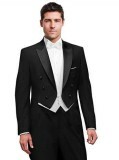
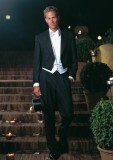
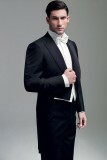
- Complement the shirt with a white vest and front shirt, also starched. The modern image assumes that the bottom corners of the waistcoat are 1-2 centimeters peeking out from under the front half of the coat.
- Value and significance of the image will give expensive and quality buttons on the waistcoat and shirt. Well, if they are made of natural pearls or mother-of-pearl. But the fancy buttons can be made of dark silver and even diamonds. Cufflinks of the shirt, unlike the buttons, should not be conspicuous.
- Pants of a tuxedo pair are particularly easy to distinguish: they are narrow, with a high belt, side sewn two silk stripes-lamps, which are correctly called galloons. Historically, it turned out that the trousers of this costume should be on suspenders, since they were wearing this outfit, including balls, where the cavaliers had to dance a lot, and losing their trousers during the dancing was inadmissible.
- If you strictly follow the etiquette, then the white pocket handkerchief can be an addition to the costume, when it is not supposed to put on the order. But even without that, the other image will not become less significant and solemn.
- In the classical version, the left lapel has an inconspicuous hole for the buttonhole, and if sewn by a knowledgeable master, then on the back of this lapel there will be a holder for the flower. It is not out of place in a festive setting to take advantage of this feature of the frock coat.
- In cool weather, a long coat is worn over the tailcoat and complemented with white gloves.
Where and when it is appropriate to wear it
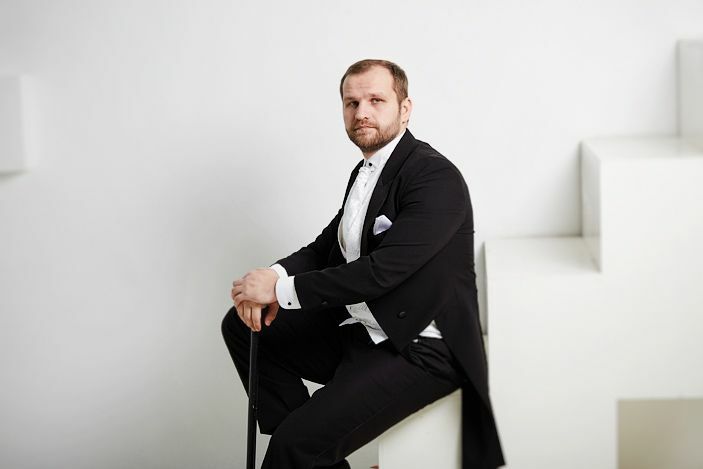 In our time, many events are held, to which you can be invited, and where you want to see in the dress coat. In such cases, even the invitation will indicate "White Tie" or "Evening Dress", which means that you need to be in a white bowtie at the evening event. For information: according to the rules of etiquette, the time for white bow ties is only evening, after 20.00.
In our time, many events are held, to which you can be invited, and where you want to see in the dress coat. In such cases, even the invitation will indicate "White Tie" or "Evening Dress", which means that you need to be in a white bowtie at the evening event. For information: according to the rules of etiquette, the time for white bow ties is only evening, after 20.00.
- Today, tailcoats are relevant at wedding ceremonies, formal evening receptions, at awards ceremonies or an important award, while visiting the opera and other theaters.
- White coat is worn very rarely even in countries that are considered fashion trends: England and France. But if it's appropriate to wear white, then only in the warm season for activities that take place in the fresh air.
- Today, the tailcoat plays the mandatory clothing in ballroom dances, during the execution of the European program.
- It is also a uniform for sportsmen in competitions in equestrian sport. Of course, its appearance and even tailoring differ from the classical version, but this is for the convenience of the rider.
Basic rules of
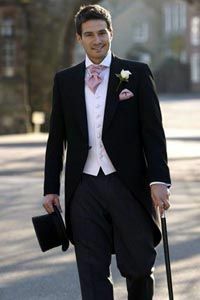 The tailcoat is sewn from a quality, natural or mixed woolen fabric, it must fit tightly around the figure, not to be folded on the back or folds. Therefore, before you put on the ready bought coat, it must necessarily be fitted to the figure.
The tailcoat is sewn from a quality, natural or mixed woolen fabric, it must fit tightly around the figure, not to be folded on the back or folds. Therefore, before you put on the ready bought coat, it must necessarily be fitted to the figure.
- A waistcoat, worn by men under the coats, ideally should be made of fabric pique. It is a dense cotton fabric, its feature is that it almost does not crumple, it is not smooth( in a fine hem), ideally white, it is easily erased. A waistcoat made of a different fabric, for example silk or satin, is considered unacceptable in the classic strict combination.
- Lapels are trimmed with natural silk, by the way, you can sew and buttons of a coat, and trouser stripes. Although there are possible options in which the lapels of the coat are lined with the same fabric as the main suit.
- At ceremonial events, often invited attendants are dressed in tailcoats - as uniforms. In order not to be confused with the waiter, remember that a black waistcoat and a bow tie are for those who serve the event.
- The shirt, waistcoat and shirt must be perfect, because the coat is always unbuttoned, even the cut does not imply that it will be fastened. The waistcoat, on the contrary, has three buttons that are fastened necessarily.
Posture - straight, severe, full of grandeur and nobility. This is how you should look like a gentleman wearing this outfit. Perfect manners have to learn, useful in any case.
Can women be dressed for women?
Female tailcoat also has a place to be, and a beautiful floor does not even have to comply with all the conventions and rules of etiquette.
- You can wear it to women with any trousers and even leggings. Pants can be narrow, wide, long, short( almost like shorts), interesting combination with trousers breeches.
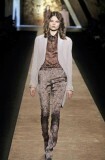
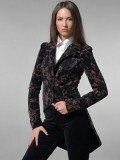
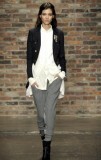
- Unusually, and, therefore, attractive for any look the female version will look with skirts or dresses, it is important to choose the right combination of colors and texture of the dress.
- In contrast to the requirements that a strict dress code offers to men, women do not have to wear a shirt for coats. These can be blouses, vests without shirts, T-shirts and tops.
- The colors of the female image are more than democratic: any bright, juicy - to pale blouses and tops or light - to a darker bottom.
Several historical and literary facts
- This appearance of this kind of clothes is due to the cavalry officers, whose uniform should look exactly like this and nothing else: the rider in any case and in front, and from the back should look strictly and elegantly. In the initial versions, the front floors were folded to the waist and buttoned.
-
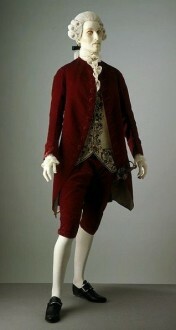 Once the tailcoats were exclusively military clothing. Officers in those distant times( France, the 18th century) were almost all of the upper class, often appeared at parties and parties, and the coat gradually became clothing, worn in especially solemn occasions by officials and representatives of the highest nobility.
Once the tailcoats were exclusively military clothing. Officers in those distant times( France, the 18th century) were almost all of the upper class, often appeared at parties and parties, and the coat gradually became clothing, worn in especially solemn occasions by officials and representatives of the highest nobility. - In the literature of the 18-19 centuries, there were often heroes who wore these clothes. Thanks to classic writers, we know that earlier tails could be not only black or dark blue. For example, in Leo Tolstoy, Pierre Bezukhov wore a green coat, while in Nikolai Gogol the famous Chichikov had a cowberry-colored dress.
Video on the subject:
 3:53
3:53  2:48
2:48  1:53
1:53 